Picking Cotton In The Age Of Facebook
“Cotton, it seems, has surrounded our old farmhouse for most of its existence, save for those occasional years or decades when the price of cotton was so low as to make it unfeasible for farmers to raise it . . . .” —William A. Balk, Jr.
Epicurus’ Porch
By William A. Balk, Jr.
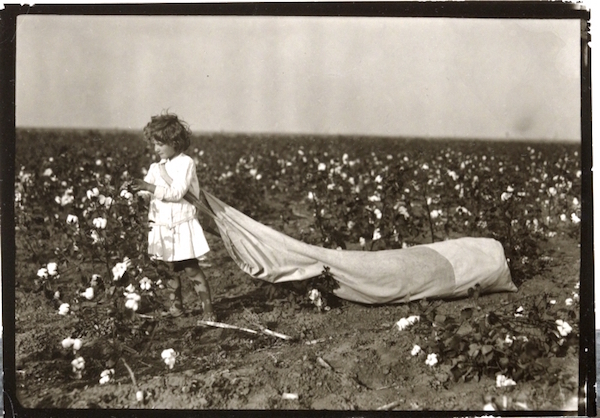
ELKO South Carolina—(Weekly Hubris)—11/2/2015—A short drive, or a shorter walk, from the old farmhouse here on the upper coastal plain of South Carolina soon presents a landscape of farmers’ fields, separated sometimes by windrows of pine, oak, chinaberry, and laurel cherry trees.
Larger woodlots of planted pine or self-sown hardwoods and conifers interrupt the planted or fallow fields, and the entire terrain of sandy clay soils undulates with the low rise and fall of hills and valleys created by millennia of gentle erosion.
The “hills” are occasionally high enough to confront a cyclist with a change in gear.
The “valleys” are rarely deep or steep enough to allow us to call them that, though there are areas that have that word in their names. On the coastal plain, the name “Valley” will usually have been supplied by a developer who dreamt of locales with steeper geography. Rather, our usually gentle creeks and streams drain watersheds only a few feet higher than the streams themselves. A waterfall of a mere foot in height is a geological wonder, likely the result of an errant slab of sedimentary rock not yet eroded into its sand-and-shell components to become the pale sand creek bed through which the clear black water flows.
It is, indeed, clear and black, this slow water coursing from small streams into the larger rivers of the Lowcountry: Edisto; Combahee; Salkehatchee; Ashepoo; Pee Dee; Santee. The great “Black Water” rivers of our coastal plain, made so by the dark tea stain of thousands of years of accumulated leaf litter in the forests that have covered their flood plains, these rivers were the centers of life for the first peoples of the area, and it is their names for the rivers that remain, musical and sweet on the tongue.
They have remained centers of settlement for hundreds of years, at least at the headwaters and mouths of the rivers. The headwaters of many of the Black Water rivers mark the so–called Fall Line, delineating the geological escarpment some one hundred or more miles inland where the granitic bedrock at the surface yields to the sandy remnant left behind the sea’s furthest advance inland tens of thousands of years ago. The rivers’ mouths present ideal bays and sounds for ports; and seafaring colonists made their first cities there.
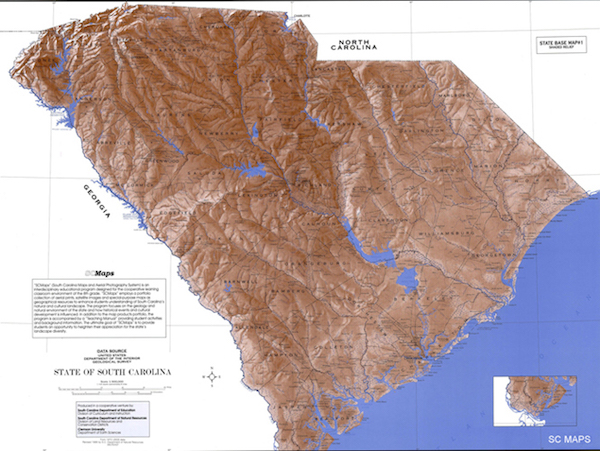
The land between, however, blessed with streams, forests, and broad expanses suitable for clearing and planting, soon was settled more sparsely, its expanses devoted to farming, timber, and hunting. It remains largely so even today, although its purely rural identity is under considerable pressure from a number of directions.
It is here, in this gently rolling land of white sand and black streams, of productive woodland and fallow fields, that our old farmhouse has sat for nearly two centuries. Once called the Carolina backcountry, closer to the Indian trading post of Augusta on the Georgia side of the Savannah River than to the urban metropolis of Charleston, this coastal plain has remained in some ways a backcountry to this day. Now, as then, newcomers arrive from distant places, seeking an escape from urban challenges or hoping to start anew.
The curving paved road which passes by the farmhouse is one of the farm-to-market roads built in the last century to support the burgeoning truck farming industry, so-called because the produce—asparagus, watermelons, cantaloupes, cucumbers—was harvested and hauled to market in trucks, which had replaced the train as the means of transport for local produce. Not all such roads were paved, and today within a mile or two of the farmhouse there are a number of well-traveled unpaved corridors connecting farmsteads to small towns.
Only a short distance from the farmhouse along any of these roads, just beyond the pine lots or across the little creek, the fields of various neighbor farmers appear. As is typical of much of the farmland in this area, these fields are often small compared to the great leveled expanses of industrial farms in the Midwest or American West.
My neighbor, Mr. Nix, who farms more than a thousand acres, perhaps much more, plows and plants fields as small as the ten-acre field just up the road, with larger expanses nearby or even several miles away. It is certainly not the most efficient way to farm, driving great pieces of machinery over significant distances, consuming fuel and time in unproductive travel. It offers, however, the chance to adapt crops and schedules to the unique qualities of each locale.
A mile or so in one direction from the farmhouse, Mr. Nix grows a 15-acre field of peanuts, a crop which sometimes requires irrigation, always requires attention, and needs a peculiar treatment for harvest. Peanuts are seeds—the result of the leguminous plant’s flowering and being successfully pollinated. Once pollinated, the flower sheds its petals, begins to develop an embryonic seed, and extends itself toward the ground. Once it touches the ground, the developing peanut buries itself and grows into the mature peanut underground.
When the peanuts are mature, the farmer must sever the root, lift the plant, invert it with roots up and leaves beneath, and leave it to dry in windrows in the field. Several days later, a large harvester—a “combine”—separates the drying peanuts from the plants and harvests them.
A mile or so in the other direction from the farmhouse, Mr. Nix has a field of some seven or eight acres along a large highway. This field is too large to let it lie fallow, but it is small enough to be difficult to find a crop which will be profitable to plant here. It has at various times had soybeans, corn, and cotton growing in it. I have no idea if the fuel, fertilizer, labor, seed, and machinery costs of this little field are ever met, but—faithfully, yearly—the plot is prepared, planted, cared for, and harvested. At times, the farmer experiments with different approaches; for a couple of years I noticed he was trying a “no-till” approach, leaving the soybean stubble from the last year and planting another crop directly without plowing and tilling the soil. I see he has gone back to tilling this year.
This year it is cotton. And the other fields nearby, large and small, are all planted in cotton. Cotton, it seems, has surrounded our old farmhouse for most of its existence, save for those occasional years or decades when the price of cotton was so low as to make it unfeasible for farmers to raise it. In recent times, there has been some annual uncertainty about which of the primary crops to plant each year—cotton, soybeans, corn?—and farmers sometimes come to different conclusions than even their neighbors; some decide to diversify their own plantings. Clearly, this year, Mr. Nix leaned strongly toward cotton.
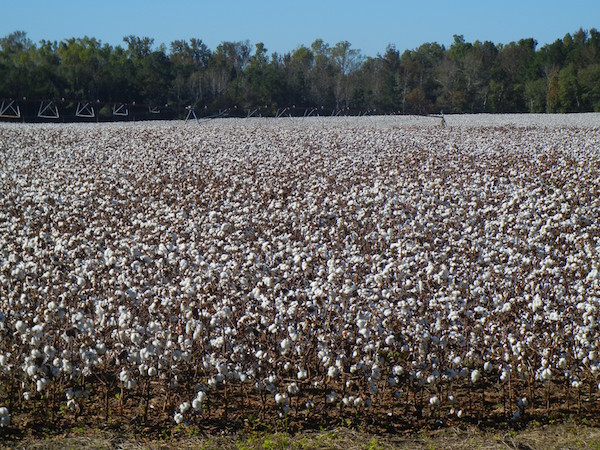
The story of Eli Whitney’s 1793 invention of the cotton gin on a Georgia plantation is widely taught in our state’s schools. This contraption made it possible economically to remove the seeds from the fiber of picked cotton, an incredibly laborious and time-consuming task which had always had to be done by hand. Thus, the huge cotton industry of the 19th Century was born.
Still, the cotton itself had to be picked from the plant in the field by hand; a task I had to perform many late summers when I was a youth. It was hot, itchy, back-breaking labor; pay was by the weight of the cotton fiber in one’s “croker-sack,” 30 to 50 cents a hundred pounds.
Properly picked, the wad of white cotton fiber was pulled out of the opened seed casing, or boll (pronounced “bowl”), and placed in the croker-sack thrown over the shoulder and dragged behind. The cotton plant was four to six feet tall and bore bolls in several stages of readiness, so several pickings were required over several weeks as the bolls ripened. An experienced picker could pick 500 pounds of cotton a day, perhaps even a thousand. It had always been done this way, but it was terribly inefficient.
My father’s first job after returning from the Second World War was as a researcher developing mechanized methods for harvesting cotton. In the late 1940s and early 1950s, his work with the USDA and International Harvester resulted in the spindle-harvesting cotton combines in use all over the world today. Providing an efficient means for harvesting made cotton once again a major agricultural commodity; and the combine has directly resulted in fields of cotton growing once again throughout our farmlands.
I suppose few readers of this essay have any opportunity to drive by a cotton field, or even to observe the plant in its various stages of growth. It’s worth stopping and getting out to look, if you do get the chance. The plant itself (Gossypium) is lovely, a member of the Mallow family; its close relation to the garden hibiscus and the okra food plant is immediately obvious when the plant is in bloom.
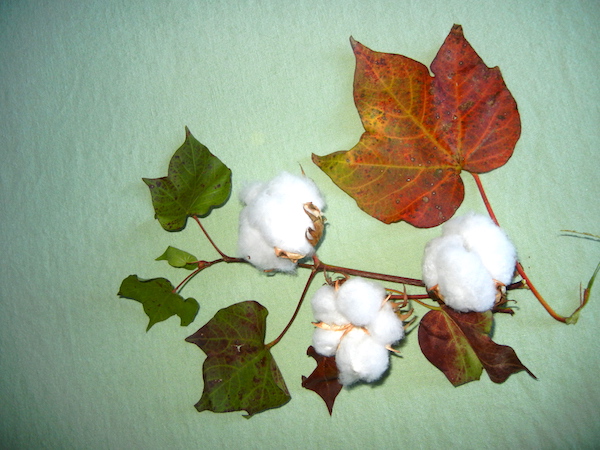
Once the flower is fertilized, the seed pod, the boll, begins to form. The cotton boll swells greatly as it matures, filling with “lint”—cotton fiber—which surrounds the seeds inside. At maturity, the boll swells to the point of bursting open into a five-sectioned pod, with the lint overflowing. This is the point at which the farmer must determine the best time for picking: too early, and most of the crop is still in the boll; too late, and the lint will have gotten too dirty and exposed to damage from the weather.
In our area, cotton is usually picked starting in October. In most cases, a couple of weeks before picking, the farmer sprays a defoliant (in my day, the defoliant used was the same ingredient that became Agent Orange during the Vietnam War) over the field so that fewer leaves and trash get picked with the cotton. The picking continues until around Thanksgiving in November, the cotton taken to the gin for processing.
Once, great square bales of picked cotton were pressed and hauled to the gin. Nowadays, the entire harvest of cotton from a field is loaded as it is picked into the metal mesh hopper trailing the cotton picking machine. The hopper is also a giant baling machine, and a massive hydraulic piston compresses tons of cotton into a huge bale the size of a mobile home. It is unloaded onto a tarpaulin or directly onto the ground and covered with a colorful plastic sheet to shed rain, waiting sometimes for months for the cotton gin to be ready to process the cotton for sale.
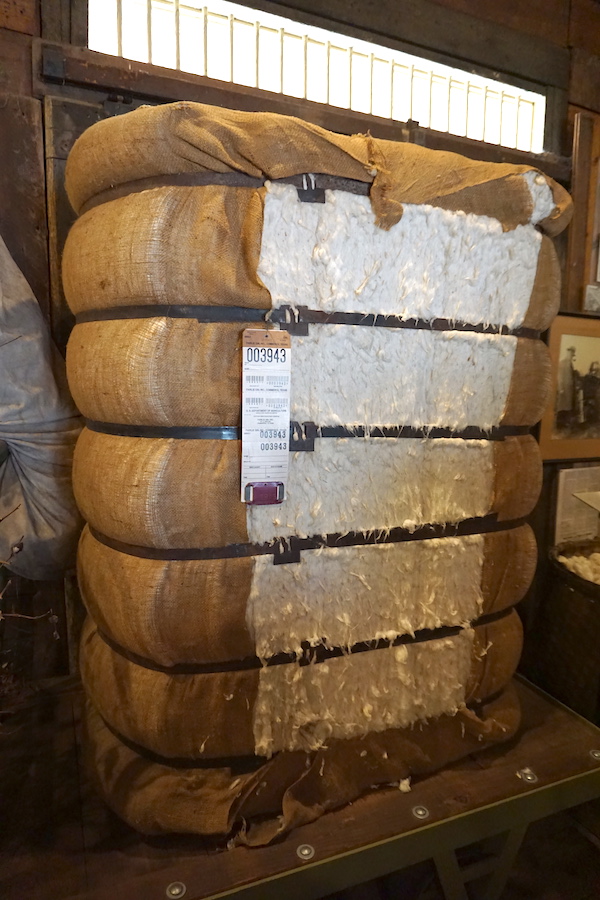
The field, defoliated and picked bare of most of its crop, looks decidedly bedraggled after the cotton picker has finished its run. The machine is many times more efficient than human hands in picking cotton from the plants quickly, but it is not perfect. The field of bare brown plants is littered everywhere with a portion of the fiber from each cotton boll left still attached, dangling forlornly, like Kleenex, from the boll. There is no cost effective way for the farmer to collect this portion of his crop; it is left as waste, hundreds of pounds of perfectly good (at least, until the first rain) cotton left to be cut with the remaining stalks and tilled under.
Cotton, a tropical or subtropical plant, is by nature a vigorous grower; a hungry consumer of nutrients from the soil in which it grows. It is also a thirsty plant. In the early years of the last century, vast acreage in the American South and elsewhere that cotton was grown extensively was left barren and riven, depleted of nutrients consumed over the years of cotton crops.
Modern farmers supply vast quantities of chemicals to cotton to produce a successful crop: fertilizers to replace nutrients lost to the last crop; insecticides to combat invasions of leaf-eating insects and egg-laying weevils bent on destroying every boll in a field; fungicides to reduce the depredation wrought by too much moisture; defoliants to force the plants to drop their leaves before picking. In our area of the South, sufficient rainfall usually comes in the growing season, although a number of farmers employ irrigation to supplement rainfall when it is insufficient.
Each autumn, we become accustomed to the roar of small airplanes seemingly just above the trees, power lines, and rooftops, zooming over us repeatedly as each cotton field receives its aerial bath of defoliant. In contrast, in our neighborhood, anyway, the chemical insecticides are applied at plant– or ground–level, reducing the possibility of wind-blown spread of the potent poisons.
Literature and our culture mark seasons’ changes with the usual mnemonic images: the snow-covered hills and trees of winter; spring’s burst of tulips and the arrival of songbirds; the swimming holes, beaches, food-laden picnic tables of summer; and the colors of turning leaves in fall.
Those of us fortunate to live surrounded by farms, intimate with farmers, become engaged, instead, with the seasons’ coming and going as visceral experiences. If one lives at the seashore, if one knows sea-going neighbors, the daily rise and fall of the tides becomes another body-rhythm, alongside one’s heartbeat and breath. In farm country, the times of planting and harvest, the smell of fields of plowed soil or of corn in silk—these are integral to our being.
Native peoples first saw, and then employed, these same cycles and rhythms along South Carolina’s streams and in these woodlands. They cleared open areas and cultivated early crops—many of which are still sown and harvested here today, like beans, and maize.
Centuries of immigration from other lands have brought new crops, new methods, new people to this rural corner, yet many here still retain much of the reverence and respect for those essential cycles of growth and harvest that our forebears found here. Our challenge—among many other challenges facing our struggling corner of the world—is to find a pathway ahead, providing a livelihood for us all, while retaining the most cherished and valued aspects of this intimate relationship among the inhabitants to the rich productivity and soul-enriching character of the land and the countryside.
Somehow, we are to do that task while engaging increasingly and inextricably with a finance-driven “World,” writ large. I occasionally—nay, often—feel I am drawn instead to a decreasing and extricable engagement with that world: the bucolic curmudgeon, albeit one who still cherishes good cotton clothing.
![]()
Note: The first and last images derive from Wikimedia Commons and are in the public domain; the third and fourth images are by the author and are also available from Wikimedia Commons; the watershed map of South Carolina derives from KnowItAllMedia.com.
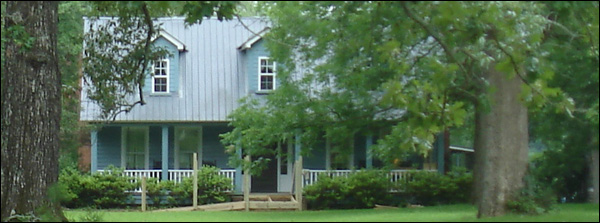

4 Comments
Mary Laura Jones
So glad to hear from you, Will. Both essays totally delightful and healing. I hope you are planning to publish a book. And I look forward to talking to you again.
All best, Mary Laura
Will
Thanks, Mary Laura. You have been on my mind the last month – your old neighborhood in Columbia, if I can remember that far back into the past, were ground zero for the terrible floods. So many suffered so terribly – and are still suffering; such a beautiful part of town, too.
Hugs to you and your vast and varied family!
Anne Roberts
The history, the land, the industrialized farming practices, Mr. Nix — so much I never knew or considered before — YES — I’m ready for a book from this low country farmer and “flnneur”.
Will
Thank you, Anne. This week we had rains, so the cotton fields are looking especially folorn!